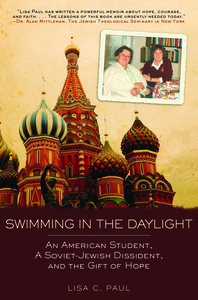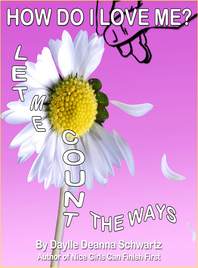 Courage and perseverance can make goals real, as shown in this interview with Lisa Paul. In 1984, as an American college student and nanny living in Moscow, she came to Inna Meiman’s house for her first Russian language lesson and a friendship began. In her new book, Swimming in the Daylight, Lisa chronicles Inna’s struggle to obtain a visa to America for medical treatment for her cancer. The Soviet Union refused her permission to emigrate and get life-saving cancer treatment in Western countries. Inna said this was a form of Soviet persecution of her and her husband Naum, a member of the Moscow Helsinki Watch Group fighting for human rights in the U.S.S.R., for being Jewish.
Courage and perseverance can make goals real, as shown in this interview with Lisa Paul. In 1984, as an American college student and nanny living in Moscow, she came to Inna Meiman’s house for her first Russian language lesson and a friendship began. In her new book, Swimming in the Daylight, Lisa chronicles Inna’s struggle to obtain a visa to America for medical treatment for her cancer. The Soviet Union refused her permission to emigrate and get life-saving cancer treatment in Western countries. Inna said this was a form of Soviet persecution of her and her husband Naum, a member of the Moscow Helsinki Watch Group fighting for human rights in the U.S.S.R., for being Jewish.
Spurred by outrage and desire to help her friend, Lisa returned to the U. S., vowing to get Inna out of Moscow. She staged a hunger strike, held a press conference, and galvanized American politicians to fight for Inna’s freedom, which eventually persuaded Mikhail Gorbachev to issue Inna a visa in December 1986. At a time when international strife seemed insurmountable and worries at home seemed paralyzing, this story is a solid example of how courage and willpower helps individuals have the power to change the future. Here’s what Lisa said:
What is the one thing you would like people to take away from your story? That they can get through the most difficult times in life in daylight and hope–not in darkness and despair.
When living in the Soviet Union, what did you come to appreciate most about your life in America? That I am free to be and do and go and think; that I am free to live the life I chose to live. I met people whose lives were ruined by acts of expression that were as routine to me as breathing: the books I read, the thoughts I write, the God I believe in, the right to travel, and my political opinions.
What advice would you give to college students today looking to make a difference in the world? To believe that they can! To take the first step by doing what is tangible to them and make it about the ripple effect: one thing leading to another and to another, instead of trying to make a huge splash overnight. To be guided by the wisdom that to try and fail is better than to do nothing at all. To rely and find strength in their internal resources instead of relying on external resources.
Have you been back to the Soviet Union since getting Inna to the U.S.? No. I had the opportunity in the summer of 1986, while working on a high level US-Soviet conference. I was the assistant to the director. The Soviets denied me a visa to attend the conference, which was in Riga, Latvia. This demonstrated to me that my hunger strike was successful because the Soviet government had heard the noise I was trying to make about its refusal permit Inna to travel to the West for medical treatment. I do not have a strong desire to return to Russia. I think for me it would feel like a ghost town and would be too painful because I had to leave so much behind when I left there.
What gave you the strength to take your fight so far and how did you keep yourself going? My fight was fueled by my faith, the love and support of my family, the love and support of Inna and Naum, and by the great desire I felt inside to try to help Inna. I knew the rest of my life would not make any sense unless I tried to do something for her. I kept myself going by taking it a day at a time and believing that what I accomplished each day would, in the long run, make a difference, that what I had to offer and what I was doing would be enough. It was an exhilarating time for me because people noticed and were interested in what I was doing, first in Minneapolis, where I began my hunger strike and where I was a student at the University of Minnesota, and then in my hometown of Appleton, Wisconsin. People understood the message of the action I was taking and supported it, and that inspired me.
How did you figure out what would get the most attention? I knew that media attention on refuseniks and dissidents was the most effective way to hold the Soviet government accountable because it caught them in the very conduct they denied was happening. To the West, Soviet authorities would proclaim, “we have no problem with Jewish emigration, we have no problem with human rights abuses.” Yet, internally, they had all but locked the door for Jews to leave and internally, they immediately silenced all voices of dissent and trampled all over the basic rights of Soviet citizens.
I knew I needed to take a drastic action that would call attention to me so that I, in turn, could focus the spotlight on Inna. I figured out that I had to do what was possible instead of trying to do what was impossible. So, I started with what was tangible to me – an interview by the University of Minnesota campus paper, which was the front page story a week before my hunger strike began. The circulation of that paper at the time was 50,000, so that was a great start. A reporter from the Minneapolis Star and Tribune called after reading it. That led to a very nice article in the Star and Tribune the morning my hunger strike began. I sent that out to media outlets and landed a story in USA Today a week after my hunger strike began. The USA Today article lead to a call from someone in Washington, D.C., who helped plan a press conference for me at the U.S. Capitol, where I ended my hunger strike after 25 days. I was lucky that I knew at that young age that the best way to get to the top of the staircase was not to try to just leap for the top step, but rather, to start with the first step and keep climbing one step at a time.
Why is it so important to believe you can make a difference? Because if you don’t believe that you can, no one else will. People might cheer you on once you get going, but you have to believe in yourself and find your path first so that others can follow.
How did you feel when Inna finally got to the US? When I watched Inna’s plane land at Dulles Airport and saw her come through the door into the airport, I felt like I was watching a miracle; I felt like I was awake in dream. I knew at the time that I would likely never experience a greater moment in all my life, even if I lived to be 100 years old. I was so in awe of Inna’s courage and optimism and strength, seeing her at the podium talking at her press conference took my breath away–it was really a moment of great and extraordinary beauty. I was so grateful and happy to be there to see it. I was so grateful and happy that I even knew her.
How will this accomplishment be a motivation or reminder as you go forward with your life? My friendship with Inna forever changed the lens by which I view the challenges in my life. In more recent years, when there were times I felt like my troubles were getting too great and I was sinking into a place of despair, I went back to the letters we wrote to each other, I went back and looked at the photo of me greeting her at the airport, and I found strength and hope, I found daylight. When Inna was in the hospital in Georgetown, she told me, “Leez, if you could do all that for me, you can do anything.” In those first months and years after she died, and all my sense of purpose and direction were gone, I often heard her telling me those words. They inspired me to go forward and live a meaningful and happy life. I have come to appreciate that they really mean I can be strong enough for whatever life throws my wa
y, which I think is the best any of us can do. It is what I am trying to teach and give my children–that they can be strong enough on the inside to get through adversity.
Because of Inna, I know that there is never a time to give up, that there is never a time to lose hope, that there is never a time to take for granted all the rights, freedoms, and opportunities I have in my life.
***********
Check out Swimming in the Daylight for a good dose of inspiration.
***********
Take the 31 Days of Self-Love challenge and get my book, How Do I Love Me? Let Me Count the Ways for free at http://howdoiloveme.com. And you can post your loving acts HERE to reinforce your intention to love yourself. Read my 31 Days of Self-Love Posts HERE.
Please leave comments under my posts so we can stay connected.

